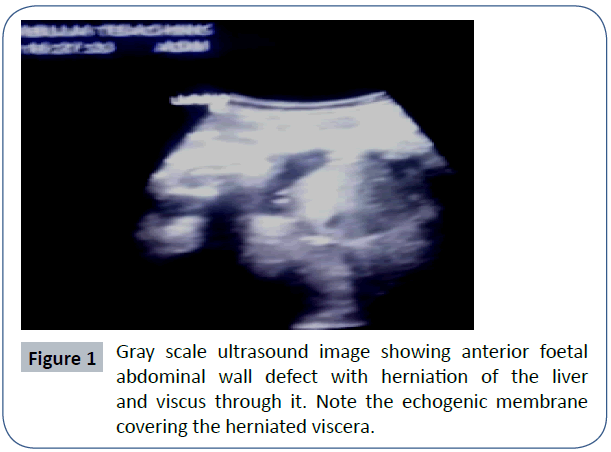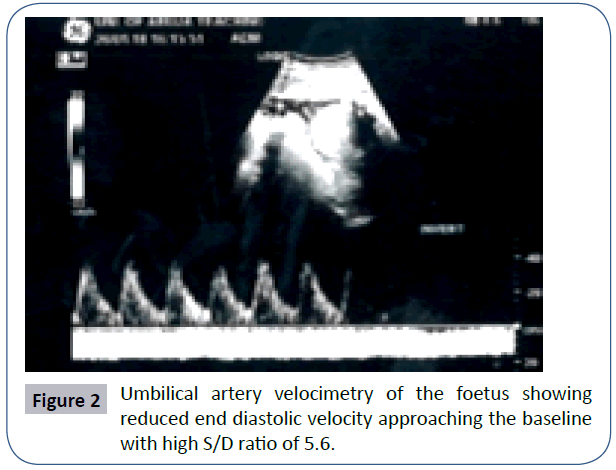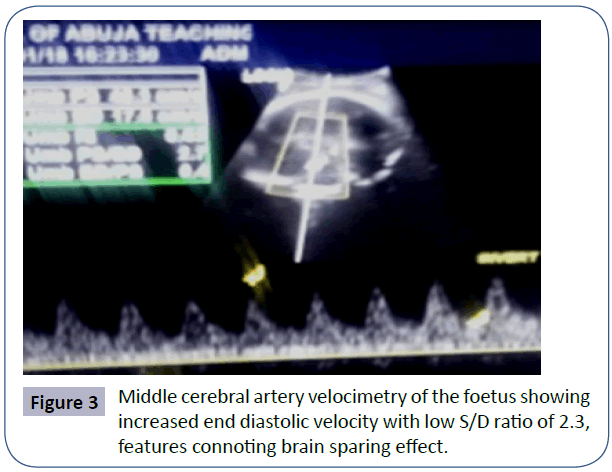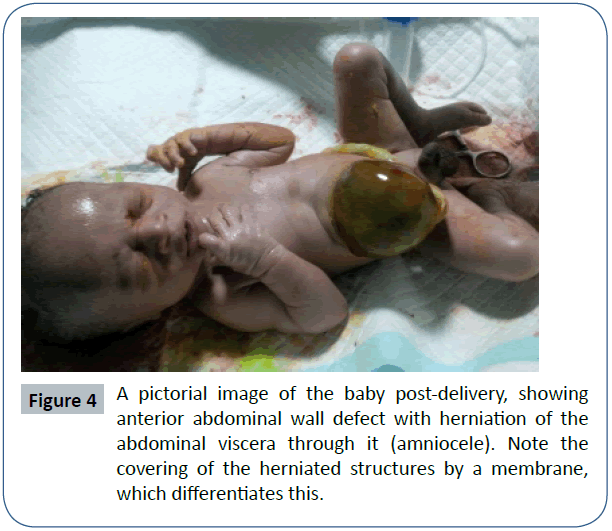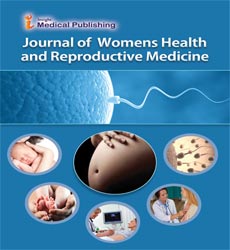Omphalocele With Foetal Distress At Term; The Utility Of Gray Scale and Doppler Ultrasound Scans In Its Management
Nongo BH1*, Agida TE1, Isah AD1 and Aiyekomogbon JO2
1Department of Obstetrics and Gynaecology, University of Abuja Teaching Hospital, Abuja, Nigeria
2Department of Radiology, University of Abuja/University of Abuja Teaching Hospital, Abuja, Nigeria
- *Corresponding Author:
- Benjamin Howe Nongo
Department of Obstetrics and Gynaecology
University of Abuja Teaching Hospital, Abuja, Nigeria
Tel: +234810279992
Email: bennongo@yahoo.com
Received Date: November 08, 2018; Accepted Date: November 28, 2018; Published Date: December 10, 2018
Citation: Nongo BH, Agida TE, Isah AD, Aiyekomogbon JO (2018) Omphalocele with Fetal Distress at Term: The Utility of Gray Scale and Doppler Ultrasound Scans in its Management. J Women’s Health Reprod Med Vol.2 No.1:12
Abstract
One of the anterior abdominal wall defects is an Omphalocele and it is thought to result from an abnormality of folding during development. The incidence of Omphalocele is 1 in 4000 to 5000 live births. It is characterized by a defect at the umbilicus through which bowel and other Intra-abdominal viscera herniate and are covered by a thin membrane consisting of amnion, Wharton’s jelly and peritoneum. The cause of Omphalocele is not yet known; there are theories that have been put forward, such as the failure of the bowel to return into the abdomen by 10-12 weeks, failure of the central migration of lateral mesodermal folds, and persistence of the body stalk beyond 12 weeks of gestation. Other foetal and congenital anomalies may also be associated with Omphalocele. Chromosomal abnormalities are seen in greater than 70% of cases. Omphalocele during the antenatal period may be detected either during routine ultrasonographic examination or while investigating the cause of an increased alpha-fetoprotein. The index case was discovered incidentally during routine obstetrics scan and the case report is therefore aimed at re-echoing the utilities of this modality in its management.
Abstract
One of the anterior abdominal wall defects is an Omphalocele and it is thought to result from an abnormality of folding during development. The incidence of Omphalocele is 1 in 4000 to 5000 live births. It is characterized by a defect at the umbilicus through which bowel and other Intra-abdominal viscera herniate and are covered by a thin membrane consisting of amnion, Wharton’s jelly and peritoneum. The cause of Omphalocele is not yet known; there are theories that have been put forward, such as the failure of the bowel to return into the abdomen by 10-12 weeks, failure of the central migration of lateral mesodermal folds, and persistence of the body stalk beyond 12 weeks of gestation. Other foetal and congenital anomalies may also be associated with Omphalocele. Chromosomal abnormalities are seen in greater than 70% of cases. Omphalocele during the antenatal period may be detected either during routine ultrasonographic examination or while investigating the cause of an increased alpha-fetoprotein. The index case was discovered incidentally during routine obstetrics scan and the case report is therefore aimed at re-echoing the utilities of this modality in its management.
Keywords
Fetal distress; Ultrasound scans
Introduction
Omphalocele is a rare birth defect. It is a type of abdominal wall defect in which the bowel, liver and other abdominal organs protrude out of the abdomen and into the base of the umbilical cord. The incidence of Omphalocele is 1 in 4000 to 5000 live births. It can be diagnosed by prenatal sonography. Omphalocele differs from gastroschisis in that the protruding organs are covered by the omphalocele sac. The prognosis for a baby with an omphalocele largely depends upon the size of the herniation and the presence or absence of other birth defects.
Case Report
Mrs. AA was a 31-year-old G3P1+1, referred from a peripheral Hospital to us on account of postdate pregnancy and suspected congenital anomaly following an obstetrics ultrasound scan. There was no previous history of congenital anomaly or a family history of such. She had one previous miscarriage at 13 weeks of gestation and had one successful spontaneous vaginal delivery 2 years ago. The obstetric ultrasound scan done at presentation gave a gestational age of 38 weeks and 6 days. The fetal abdominal scan revealed a midline anterior abdominal wall defect measuring 10.2 cm on 2D imaging through which the fetal liver and some viscus herniated through. They are however covered by a thin membrane, differentiating it from gastroschisis (Figure 1). The covering of the mass was a thin membrane which had a smooth surface and the umbilical cord was attached to the apex of the herniated sac. There was no fetal ascites or other fetal anomaly observed sonographically. The Doppler assessment of the umbilical artery Figure 2 showed monophasic forward flow in systole and diastole but the end diastolic velocity of the artery was reduced, resulting in high S/D ratio of 5.6 (Figure 2). The Middle Cerebral Artery, Figure 3 showed brain sparing effect with elevated end-diastolic velocity and reduced S/D ratio of 2.3. The Umbilical vein flow was however non-pulsatile and the uterine artery velocimetry was unremarkable.
Figure 3: Middle cerebral artery velocimetry of the foetus showing increased end diastolic velocity with low S/D ratio of 2.3, features connoting brain sparing effect.
The radiological diagnosis was that of a viable term pregnancy with Omphalocele and fetal distress. In view of this observation, the patient was counseled for emergency Caesarean Section, which she consented to and had. The Omphalocele was confirmed post operatively (Figure 4).
Discussion
Omphalocele occurs as a result of a defect of the anterolateral abdominal wall in the midline, leading to herniation of the intra-abdominal contents which are covered by peritoneal sac [1-4]. During the eight week of foetal development, there is a physiologic umbilical herniation, then the fetal mid gut extends into the extra-embryonic coelom, thus occupying the proximal segment of the umbilical cord [5] The bowel undergoes a 270 degree anti-clockwise rotation, the first 90 degree of which occurs by the 10th week. This occurs extra coelomically at the base of the umbilicus, when the bowel returns to the abdomen, then the remaining 180 degrees turns clockwise around the axis of the superior mesenteric artery [3]. By 12 weeks of gestation, the mid gut returns to the abdominal cavity. Failure of the bowel to return to the abdomen is one of the theories for the etiology of Omphalocele [3].
Other associated congenital foetal anomalies are common (45-88%) and their severity determines the prognosis. In our case there were no other associated anomalies on antenatal radiological assessment and clinical assessment after birth. There is an association between Omphalocele and advancing maternal age, most mothers are said to be above 30 years [6,7] and our patient was 31 years of age. The diagnosis of Omphalocele during the prenatal period is based on the identification of midline abdominal wall defect, visualization of a sac which has herniated with its visceral contents and the insertion of the umbilicus at the apex of the sac [8]. This were all seen in our patient (Figure 1). Whenever the sac is seen on ultrasonography, it confirms the diagnosis of Omphalocele and virtually excludes gastrochisis [8]. This formed the basis of the radiological diagnosis of omphalocele in the index case. The contents of the sac could be loops of intestine, liver and stomach [8], and this is similar to the observation made in the index case other than the stomach that was not part of the sac contents (Figure 1). Ascites which is commonly seen in the sac was absent in our case. The size of the anterior abdominal wall defect may range from a simple herniation of the cord, which contains a few loops of bowel to giant Omphalocele in which part of the liver protrudes [8]. Our case was a giant Omphalocele, as the defect measured 10.2 cm on ultrasonography. Oligohydramnios which may complicate Omphalocele because of associated pulmonary hypoplasia was not seen in our patient as the Amniotic Fluid Index (AFI) was 12.27 cm at term.
Omphalocele could co-exist with other foetal congenital malformation syndromes and chromosomal anomalies [9]. It is most commonly associated with Beckwith-Widemann Syndrome, which is characterized by Omphalocele, organomegaly, gigantism, hemi hypertrophy and polyhydramnios [10]. This was not seen in our case. Chromosomal anomalies are also associated with Omphalocele; these include trisomy’s 13, 18 and 21, Turner, Klinelfelter and triploidy syndromes [11,12]. We did not have the facilities in our hospital, to determine if there were coexisting chromosomal anomalies but there were no telltale signs of such at the moment and if need be, referral shall be made to appropriate hospital for karyotyping at a later date. When polyhydramnios or oligohydramnios occurs in association with Omphalocele, the risk of chromosomal anomalies increases but both were not appreciated sonographically in the index case, making us exclude the possibility of chromosomal anomalies.8 Magnetic Resonance Imaging (MRI) can also be used to make a prenatal diagnosis of Omphalocele but this has no significant advantage over ultrasound and it is not cost effective. There are differential diagnosis of Omphalocele which include, blood clots, pseudo-omphalocele, pentalogy of Cantrell, amniotic band syndrome, exstrophy of urinary bladder and cloaca, physiologic bowel herniation, umbilical hernia, gastroschisis, body stalk anomaly, cardiac monster and cavernous hemangiomas.8 These were convincingly ruled out sonographically. When a diagnosis of Omphalocele is confirmed in the antenatal period, it is important to carry out fetal karyotyping and to diligently assess the fetus for other congenital malformations [13]. In our case, the ultrasonagraphy done ruled out any other obvious structural congenital anomaly.
Ideally management in the prenatal period should involve serial assessment of fetal growth and well-being [13]. In the index case however, pregnancy was already at term and coupled with the diagnosis of fetal distress by Doppler ultrasound scan, there was a need to expedite delivery, which was done with good outcome. Current evidence suggests that the use of Doppler ultrasound in high-risk pregnancies reduced the risk of perinatal deaths and resulted in less obstetric interventions [14]. We used Doppler ultrasound in this case because of the discovery of the large Omphalocele at term which made this pregnancy a high risk one. The use of the Doppler ultrasound here also reduced the risk of perinatal death as caesarean section was immediately carried out once the sonographic diagnosis of fetal distress was made.
In a descriptive retrospective analysis, Lurie et al. found that there is no supportive evidence to the idea that caesarean delivery of fetuses with Omphalocele is associated with an improved survival rate [1,15]. Most of the studies reviewed above did not control for confounding variables like, Omphalocele size, rate of intrapartum sac rupture, ready accessibility to treatment in tertiary centres, types and severity of associated fetal anomalies, presence of trial of vaginal delivery, type of surgical correction and post-operative morbidity.
In isolated cases of small Omphalocele, there is no evidence that vaginal delivery is safer than caesarean section. However, Lurie et al. suggested that fetuses with giant Omphalocele >5 cm should be delivered by caesarean section [1,15]. Our case had emergency caesarean section because of the diagnosis of antenatal foetal distress following a Doppler ultrasound scan and the fact that the Omphalocele size on ultrasound scan was 10.2 cm, making it a large Omphalocele. Vaginal delivery at term should be offered to cases of Omphalocele with life threatening fetal anomalies [15]. Until there is a randomized trial of vaginal and caesarean delivery for cases of fetal Omphalocele, it would seem as if the preferred mode of delivery is the vaginal route which is safer for the mother and caesarean section reserved for obstetric indications and cases of large Omphalocele as it was in the index case. Following delivery, the baby was handed over to the paediatric surgical team in our hospital for further management of the Omphalocele.
Conclusion
Fetal Omphalocele is the commonest fetal anterior abdominal wall defect. With the wide spread use of ultrasound in the antenatal period, it is possible to diagnose this condition now. Follow up of this condition during the prenatal period is necessary. Appropriate decision as to the mode of delivery, should be at term, taken in the absence of any emergency.
References
- Peranteau WH, Tharakan SJ, Partridge E, Herkert L, Rintoul NE, et al. (2015) Systemic hypertension in giant Omphalocele: An underappreciated association. J Pediatr Surg 10: 131.
- Johnson JM, Nyberg DA (1998) Chromosomal abnormalities. In: Rumack Carol M, Wilson Stephanie R, Charbone-Au J William (eds.). Diagnostic Ultrasound, 2nd ed. Mosby; St. Louis pp: 1192-1193.
- Som PP, Naik S (2008) Antenatal diagnosis of omphalocele. Med J Armed Forces India 64: 276 -277.
- Ali B, Shetty A, Mckee J (2015) A novel approach for the closure of challenging giant omphalocele. Elsevier 3: 485- 488.
- Peters NC, Hooft ME, Ursem NT, Eggink AJ, Wijnen RM, et al. (2014) The relation between viscera abdominal disproportion and type of omphalocele closure. Eur J Obstet Gynecol Reprod Biol 181: 294-299.
- Curry JI, Mckineey P, Thornton JG, Stringer MD (2000) The aetiology of gastrochisis. Br J Obstet Gynaecol 107: 1339-1346.
- Tan KH, Kilby MD, Whittle MJ (1996) Congenital anterior abdominal wall defects in England and Wales 1987-93: Retrospective analysis of OPCS data. BMJ 313: 903-906.
- Agarwai R (2005) Prenatal diagnosis of anterior abdominal wall defects: Pictorial essay. Indian J Radiol Imaging 15: 361 -372.
- Bariisic I, Clementi M, Hausler M, Ajerja R (2001) Evaluation of prenatal ultrasound diagnosis of fetal abdominal wall defects by 19 European registries. Ultrasound Obstet Gynecol 18: 309-314.
- Koontz WL, Shaw LA, Lavery JP (1986) Antenatal sonographic appearance of Beckwith-widemann syndrome. JCU 14: 57-59.
- Nyberg DA, Fitzsimmons J, Mack LA (1989) Chromosomal abnormalities in fetuses with Omphalocele: Significance of omphalocele contents. J ultrasound Med 8: 299-308.
- Gilbert WM, Nicolaides KH (1987) Fetal omphalocele: Associated malformations and chromosomal defects. Obstet Gynecol 70: 633-635.
- Mann S, Bliman TA, Douglas WR (2008) Prenatal and post management of omphalocele prenatal. Diagn 28: 626-632.
- Alfirevic Z, Stampalija T, Cyte GM (2010) Fetal and umbilical doppler ultrasound in high risk pregnancies. Cochrane Database Syst Rev p: CD007529.
- Lurie S, Sherman D, Ian B (1999) Omphalocele delivery enigma: The best mode of delivery still remains dubious. Eur J Obstet Gynecol Reprod Biol 82: 19-22.
Open Access Journals
- Aquaculture & Veterinary Science
- Chemistry & Chemical Sciences
- Clinical Sciences
- Engineering
- General Science
- Genetics & Molecular Biology
- Health Care & Nursing
- Immunology & Microbiology
- Materials Science
- Mathematics & Physics
- Medical Sciences
- Neurology & Psychiatry
- Oncology & Cancer Science
- Pharmaceutical Sciences
